STEP 3. Day 1-2. How to cook grain substrate for magic mushrooms
On the previous Step 2. Types of substrates and Choose grain for spawn you've already chosen right grain and calculated the necessary volume. Now it's time to prepare substrate for spawn.
Let's get started!
What you need for grain substrate preparation
1. Any whole grain from the listed below:
Hard Red or White Wheat Berry (Amazon or Amazon)
Oat grain seeds with husk intact (Amazon)
Rye Berry (Amazon)
Barley (Amazon)
Sorghum (Amazon)
Brown Rice (Amazon)
Corn or popcorn (Amazon)
Unhulled White Millet bird seeds (Amazon or Amazon) - don't use wild bird seeds with sunflower seeds!
Hulled Millet (Amazon)
2. Optional! Hydrogen peroxide solution H2O2 3% (Amazon) or any antibiotic in pills (chloramphenicol or analogue)
3. Gypsum aka Calcium Sulfate (Amazon)
4. Vermiculite (Amazon)
5. Teaspoon and tablespoon
6. Pot with lid
7. Sieve or colander
Rinse and soak grain for spawn
This step can be applied for unhulled grain: wheat, oat, rye, barley, sorghum, corn.
❗️Skip this step for hulled/unhulled millet and brown rice
1. Rinse the grain (wheat, oat, rye, barley, corn, unhulled millet) thoroughly 2-3 times in cold tap water to get rid of dust, husks, dead bugs etc. until the water is pouring off reasonably clear
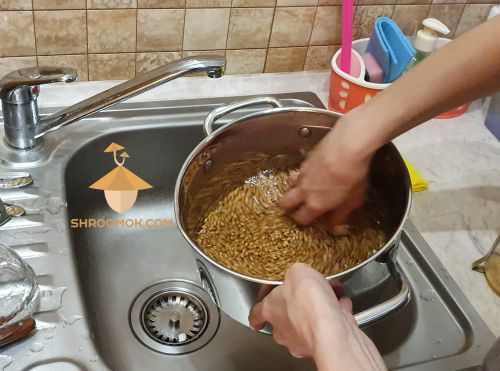
2. Pour water in clean grain (tap water or clean drinking water). Add 1 leave it to soak for 12-24 hours at room temperature, about 60-80F or +15C..+25C. No problem if you leave it to soak even for 48 hours.
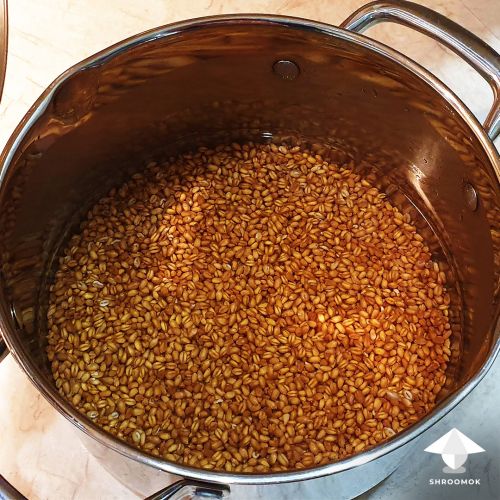
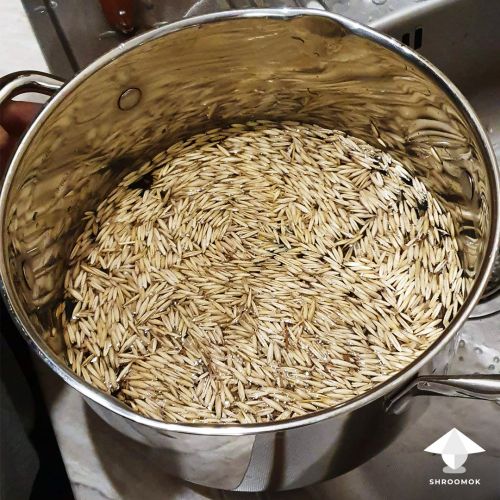
Why it is necessary to soak grain for spawn
❗️Skip this step for hulled millet and brown rice
It is optional, but I highly recommend step! Why?
First of all, grain is saturated with the necessary moisture and cooks faster.
Now the most important reason. As you know bacteria multiply by simple cell division. To do that they need water. During soaking in water bacteria and their endospores inside grain are activated, they sprout. To kill bacteria and endospores when they are woken up will be much easier and more effective.
And here we are with pressure cooker and sterilization!
After 12-48 hours of soaking you can feel a yeasty, sweet and sour smell, notice some fermentation bubbles.
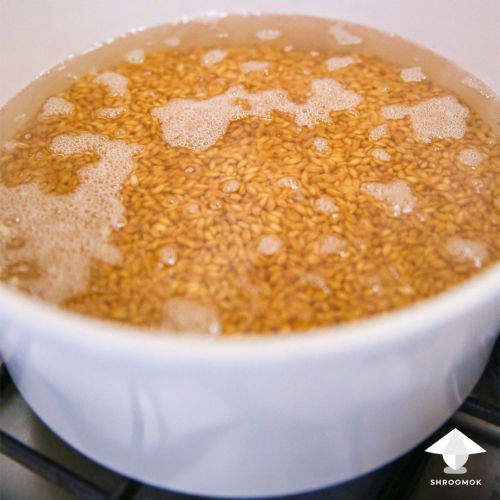
Don't worry, this is normal and great state to rid them off by simmer and the next sterilization process.
How to prevent grain substrate from sticking
Add gypsum (Amazon) to grain substrate. It is optional, but it helps to prevent the grains from sticking. For 1Qt of DRY grain add about 1-2 teaspoon of gypsum powder. Add it in water while cooking the grain or right in the grain if you use NSNS (no soak no simmer tek) as for millet.
Optional grain substrate disinfection
Optional step to prevent bacteria contamination, however antibiotics don't prevent mold contamination
1. Rinse grain after soaking 2-3 times in clean water.
2. For an extra antibacterial effect add antibiotic pill before boiling the grain. You can use hydrogen peroxide 3% solution (H2O2) instead. Antibiotic or H2O2 help to get rid bacteria off.
If you use H2O2 : add 8 oz (230-250 ml) per 1 Quart (1 Liter) of grain and 1 Quart (1 Liter) of water.
If you use antibiotic (chloramphenicol or any analogue) add it in the following proportion: 1 pill/capsule (500 mg) per 1 Qt of grain and 1 Qt of water.
The dosage of the pill/capsule is indicated on the blister
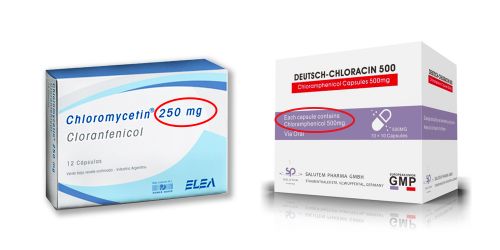
3. Grind a pill and turn it into powder. If you use antibiotic in capsules just open the capsule
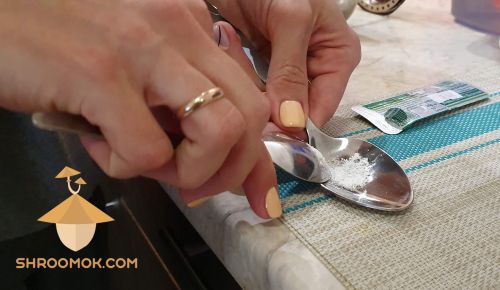
4. Pour about 1Qt of clean drinking water into 1Qt of grain
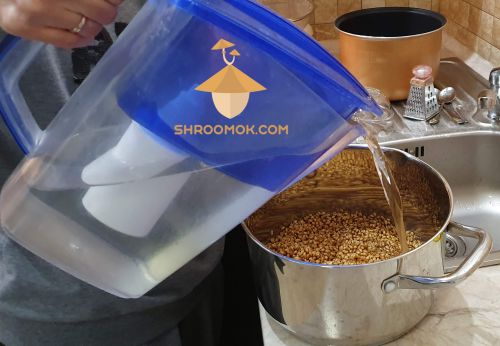
5. Add antibiotic powder (500 mg) or hydrogen peroxide (8oz or 230-250 ml)
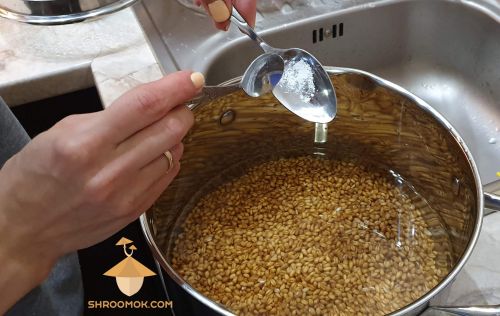
6. Mix thoroughly so that the antibiotic or hydrogen peroxide is distributed evenly
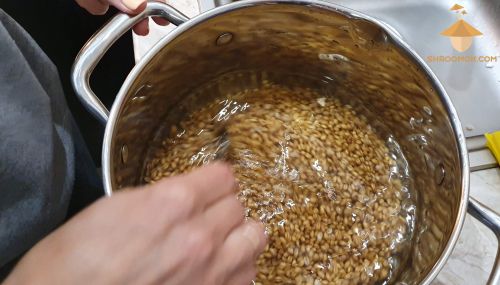
7. Ready for cooking!
How to cook grain substrate for mushroom spawn
1. Put a pot with water and grain on the stove. Bring to a boil over maximum heat (or maximum power)
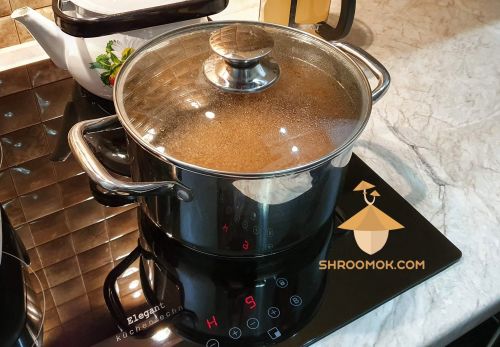
2. Turn down the heat and continue to simmer. Count down the time from this moment!
How long to simmer grain for mushroom substrate
Cooking time of grain depends not only on the type of cereals, but also on the quality, variety, place of growth, storage conditions. Countdown the time since water started to boil:
⏰ Wheat, barley, rye — about 25 min
⏰ Oats — about 10-15 min
⏰ Brown Rice — about 15-20 min
⏰ Corn, popcorn — about 50-55 min
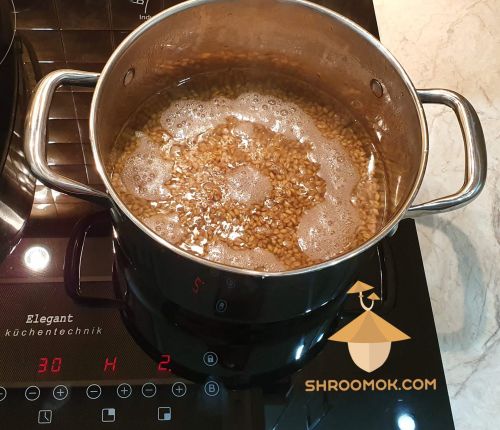
🔴 Make sure grain don't turn into mush! Such grain should not be used. Subsequently, it will become sour and will be taken over by bacteria or mold. Better to have a little bit undercooked grains
Examples of wrong grain substrate preparation
Boiled too long = too much water = too little air = bacteria contamination = trash
Here is an example of too wet overcooked grain that quickly goes sour and bacteria contamination appear. Slime appear at the bottom
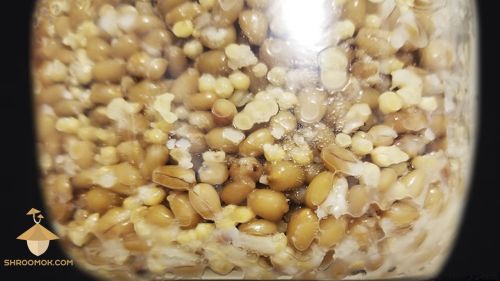
🔴 Too uncooked grain is also bad! Then the grain will not get enough moisture and the mycelium will be weak, grow poorly or not grow at all
Not enough moisture = weak growth of mycelium or no growth at all = trash
Here is an example of too dry grain substrate
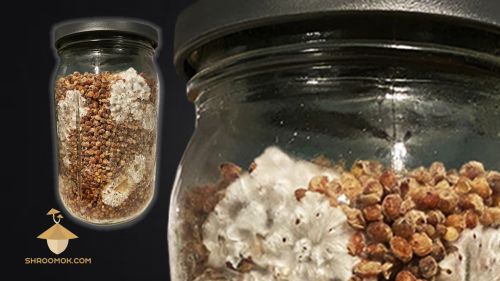
Ideal cooked grain for mushroom spawn
The grain should be springy, but soft :)
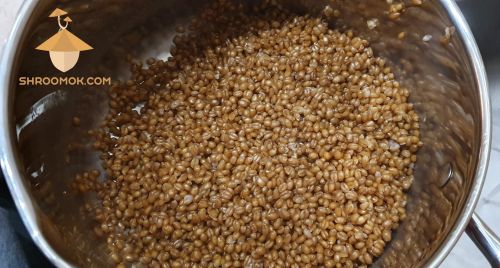
In general, if you see the first grains start to burst, it's a sign to stop boiling.
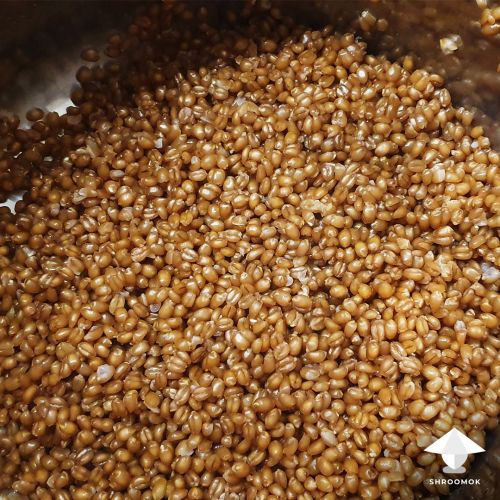
One more tip to check:
💡 Take a single grain, press it with your fingers, it should open easy. Grain is ready!
Grain should remain moderately dense and maintain the integrity of its shell. Such level of cooking should be for any type of grain: wheat, oats, barley, rye, rice, bird seeds, sorghum, millet, corn, etc.
3. When grain is ready drain the water

4. Rinse thoroughly in clean cold water
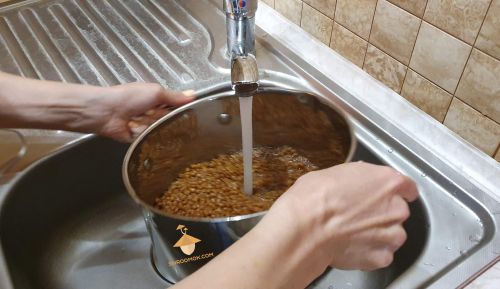
5. Throw ready grain into a sieve (or colander) to remove excess water
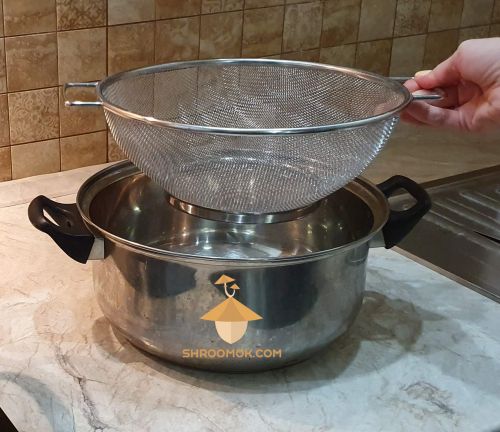
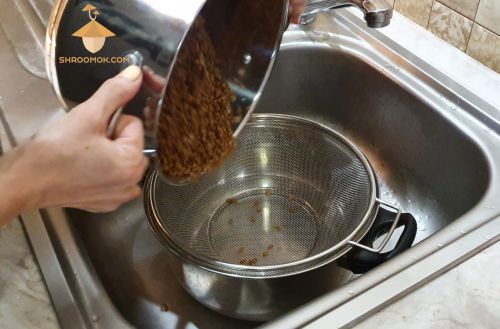
6. Leave the grain in this way for 30-40 minutes, so that excess water comes out. After boiling 1 Qt of DRY grain turns into about 1.2-1.4 Qt of cooked grain
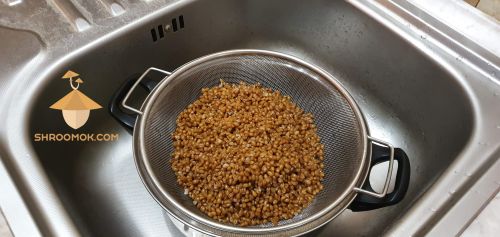
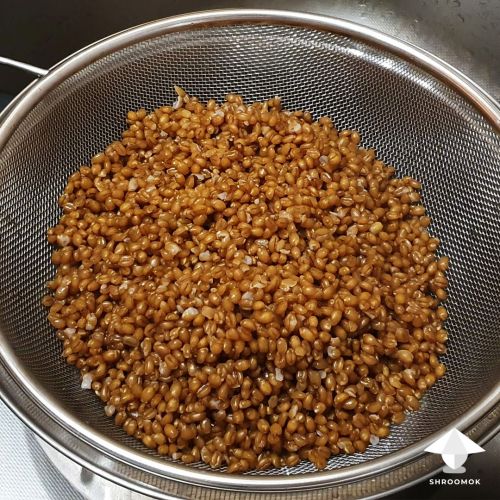
You can spread the grain on a towel in a thin layer and it will absorb the excess moisture, it will be faster. I don't do this.
❓How to determine if the grain is dry enough. Take a hand full of grain and put it on a paper towel. If the grain does not leave obvious wet prints on the napkin — it's dry enough!
7. Move grain from the sieve back into the pot. Optional! Add 2-3 table spoons of vermiculite (Amazon) if grains are still too wet or you have about 20% of opened grains
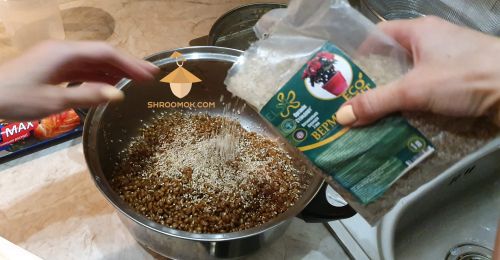
❗️I usually add vermiculite to wheat berries and brown rice. For other types of grain (corn, millet, sorghum, oat, rye) don't use vermiculite!
Vermiculite works as a drainage for wet wheat or brown rice, helps to avoid clumping and sticking. It allows good regulation of substrate moisture. If the grain is too wet, it will absorb excess moisture. If the grain loses moisture and becomes dry, vermiculite will give back absorbed moisture to the grain
🔴 Substrate should crumble in hands, be moist, but NOT WET, NOT DRY! You'll find your optimum with experience. Just take a grain in hand. If you feel it is moist, but there are no drops of water, then it's perfect state
8. Mix thoroughly to have an even mass. As a result, substrate should look like this
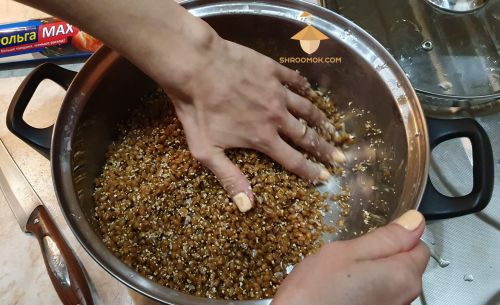
How to prepare Brown Rice grain for mushroom substrate or 10-10-15 method
I'd like to quote great tips and recipe by astora☽ — our fungi fairy on Shroomok Discord:
For anyone struggling with Brown Rice, I use the 10, 10, 15 method.
I let my water reach a boil on high heat for 10 minutes.
Then I turn it to medium heat and let my rice boil for the next 10 minutes.
After that I drain my rice and rinse with cold water and let it chill for 15 minutes before inserting into my jars.
Ready!
How to prepare Brown Rice Flour aka BRF substrate for mushroom growing
It's super simple recipe for beginners. You always have right moisture level here. Prepare as much BRF substrate as you need, just follow the right ratio:
vermiculite 2 parts, brown rice flour 1 part, water 1 part
Mix 2 cups of vermiculite (Amazon) and 1 cup of brown rice flour (Amazon). Then add 1 cup of water.
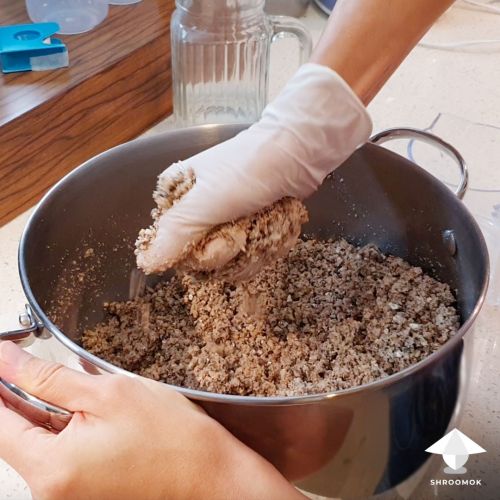
Stir it thoroughly to have even mass.
You can grind brown rice (Amazon) in coffee grinder (Amazon) to get brown rice flour any time you need.
Ready!
No soak no simmer millet substrate for mushroom spawn
Fill the jar/bag with whole white millet grain (Amazon) and just add water.
No soak. No simmer.
Water to Grain ratio: ~35-50% of water to grain (by volume).
A few examples shared by members of Shroomok Discord.
🔸 trippy: I use millet NSNS (no soak no simmer). Per each Quart jar I do 300ml millet, 150ml water with 1 tsp gypsum. Great results! Love it so far!
🔸 3EyeFlames: No soak no simmer white millet. Per each grow bag I add 1000 grams of millet (about 1300ml in volume) and 500ml of water.
How to prepare Hulled Millet for mushroom spawn
Yes, you can use hulled millet (Amazon), it's not a mistake. It is one the easiest way to prepare substrate for mushrooms.
No wash. No soak. No simmer
Just pour hot boiling water in grain. Fill completely to cover the millet (about 1 inch from the top of grain or 2 cm). Close the pot with lid and leave millet for 20-30 minutes to soak.
Drain the water with millet through the sieve.
No need to dry the grain on towels or wait for all excess water to drain. The water will continue to soak in during sterilization process in pressure cooker.
I'd like to note about vermiculite for millet. Vermiculite is a cool absorbent for wheat or brown rice, however it dries the millet very much. Don't add vermiculite to millet substrate!
Ready sterilized grain for spawn
You can buy ready for inoculation sterile grain for mushroom spawn (Amazon) and skip this and the next few steps.
Such option can save your time greatly and money for expensive pressure cooker, jars/lids/bags, even grain. It's a great option if you want to try mushroom cultivation with ease.
If you have ready sterile grain move on Step 6. Inoculation
However I suggest to handle the whole process by your own. It will be cost effective for long term mushroom cultivation hobby
What to do next
At this point grain substrate is ready for Step 5. Grain substrate sterilization
But we need right Jars or Bags for this.
Let's make one more preparation step — STEP 4. DIY Jars and Bags for grain substrate


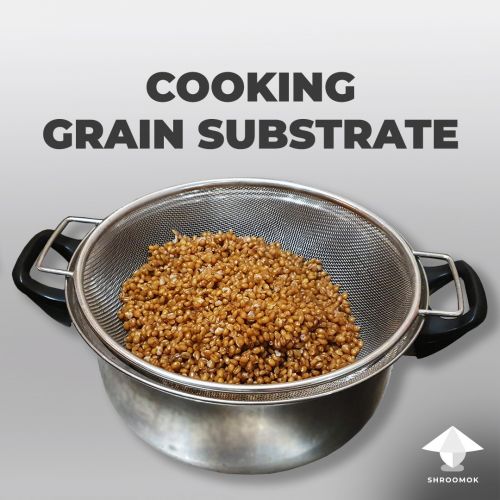
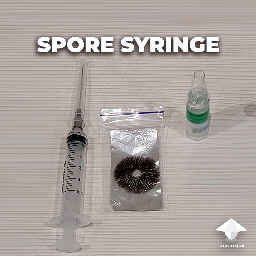
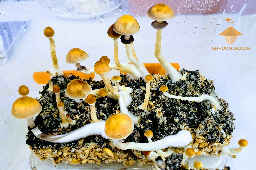
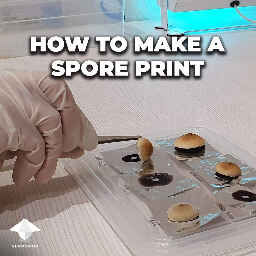
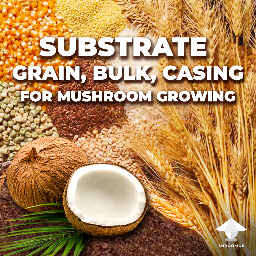
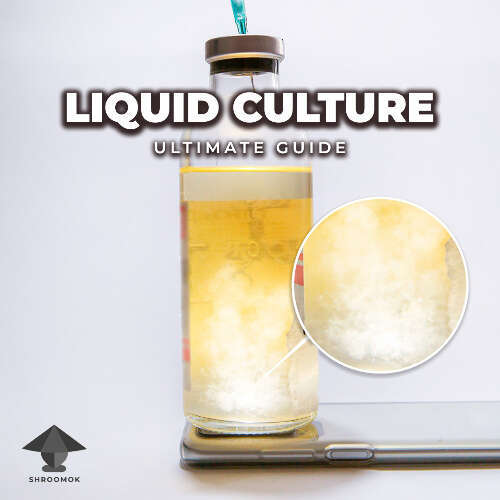
Comments
I see that you suggest using nothing but "organic" grains for spawns and substrates yet you are okay with using antibiotics for killing the bad guys. Many people avoid beef because of antibiotics in the meat. Do you not see a yellow/red flag here since mushrooms can concentrate all kinds of substances within the fruiting bodies? Just a little heads up is all. I personally would be very upset if I found out that my lovely mushrooms I was about to eat had residuals of antibiotics in them. DON'T use antibiotics for mushrooms and little else for that matter.
@Victor, I'd recommend using any type of whole grain that is safe for consumption (whether for people or animals) and is not treated with insecticides and fungicides. Avoid using grain intended for farm seedlings. Also, ensure the grain is properly stored and free from mold contamination, as some grain contaminants can produce mycotoxins.
Regarding antibiotics, they are mentioned as an optional step, not a requirement. Simply skip them, focus on proper sterilization using a pressure cooker, and work with contam-free mushroom genetics — you'll succeed for sure!
Best of luck!
Add comment